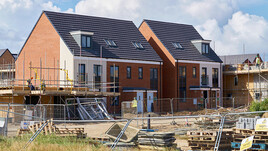
Although not without its’ critics, no-one can deny that Help to Buy has helped more than 170,000 first time buyers jump into the property market. This equates to an overall sales value of more than £54 billion. Despite its’ popularity and success, the scheme is due to be scaled back in 2021 and shelved in 2023.
 Currently there are three different types of Help to Buy scheme;
Currently there are three different types of Help to Buy scheme;
- Help to Buy: ISA, where for each £200 saved the Government adds £50
- Help to Buy: Shared Ownership, where buyers purchase a 25%-75% share of a property
- Help to Buy: Equity Loan scheme, where the government lends up to 20 per cent of the cost of new build homes, reducing the amount buyers need to provide as a cash deposit
Help to Buy Equity loans are available to existing homeowners as well as first time buyers. However, the property must be a new build, with a price of up to £600,000. With the assistance of this type of loan, more than 210,000 properties were purchased up to Dec 2018, with £11.71 billion being loaned out. This allowed the purchase of property at an overall cost of another £54 billion.
Despite being available to existing homeowners, Help to Buy Equity loans have mainly been taken up by first time buyers. Up to Dec 2018 First time buyers represented 81% of those that purchased via the H2B Equity loan route.
 The scheme has been very popular in London, where 95% of those receiving H2B Equity loans have been new buyers. The Capital also saw the highest rates of loans where the maximum deposit was applied for.
The scheme has been very popular in London, where 95% of those receiving H2B Equity loans have been new buyers. The Capital also saw the highest rates of loans where the maximum deposit was applied for.
More than a third (37%) of all Help to Buy Equity Loan sales were for properties worth up to £200,000. Around 45% of homes purchased through the scheme were worth between £200,001 and £350,000. This distribution confirms that buyers were mainly purchasing the starter level properties sought after by first time buyers. Notably, Help to Buy has primarily enabled the purchase of houses, to Dec 2018 only 17% of all transactions were for flats.
The total household income, regardless of how many members of that household are making the purchase, is recorded for Help to Buy: Equity Loan scheme purchases. Up to December 2018, only 6% of applicants had household incomes of less than £20K or more than £100K. The household income for the majority of majority of applicants was in the range of £20 to £50K.
When the scheme ends in 2023 it is predicted that developer led shared ownership schemes will become Help to Buy’s natural successor. It is of course possible that a future UK Government spending review may extend Help to Buy beyond 2023 or relaunch parts of the scheme under a new name!
 LSL Land & New Homes work with a number of Help to Buy registered developers throughout the UK.
LSL Land & New Homes work with a number of Help to Buy registered developers throughout the UK.
Kerry Hamer from Kier Living South West explains that “The Help to Buy scheme, has enabled a lot of new home purchasers, not just first-time buyers get on to the metaphorical property ladder. For a lot of people, owning your own home is the dream, so with the 5% deposit, with the Governments equity loan you up to 20% of the value of the property (a huge boost to your deposit) and to make it even more attractive, the loan is interest-free for five years, making your dream home more affordable. This scheme has effectively created thousands of new homeowners.”
When asked to comment on their Help to Buy experience, a couple that recently moved into a new home from Ediston Homes said, "Help to Buy was also really good for us allowing us to buy our brand-new home with a 5% deposit. We are really over the moon to buy our first home and particularly a new home."
*Based on data from Help to Buy (equity loan scheme) statistics: April 2013 to 31 December 2018 published by the Ministry of Housing, Communities and Local Government



